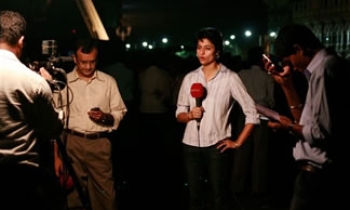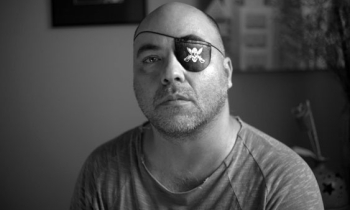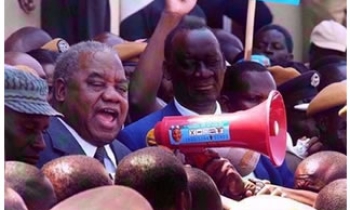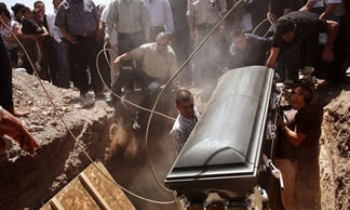NEW YORK When word mistakenly spread early Wednesday that 12 trapped miners in West Virginia had been found safe, the frenzy of rumor, hope, and unconfirmed reports swept through parts of the tight-knit area of Sago, W.V., within minutes. Meanwhile, at the command center monitoring the rescue attempt--inside a trailer-sized unit just 100 yards from the church where miner families had been gathering to wait for news--Joe Thornton, deputy secretary for the West Virginia Department of Military Affairs and Public Safety, was at the center of the storm.
"When the information first hit at about 11:45 p.m., the phone wouldn't stop ringing," Thornton told E&P on Friday, the first time he has discussed what happened that night. He estimated answering about 100 press calls, mainly during the first half-hour: "I talked to tons of news organizations on the phone, and outside I was being grabbed by others." He recalls information requests from as far away as Poland, Canada and the BBC.
Each inquiry was much the same, said Thornton, a veteran press spokesman for state agencies. Reporters wanted to know if it was true that 12 miners were found alive. His response to each, he says, was "we are hearing that 12 miners were found alive--but that has not been confirmed."
Then most of the callers, he said, followed by asking--if they are alive, what happens next? "My response was that they would have to be triaged and receive medical attention," Thornton added. "But at no point did I have confirmation of this."
As E&P details elsewhere on this site, the only other state official quoted in any press accounts about the rescue reports was Gov. Joe Manchin (speaking briefly amid the church celebration of the seemingly good news). So Thornton, at the command center, was clearly the point man for reporters seeking information about whether these miners had been found alive. If this is true, and his account of what he said that night is correct, why did so many news outlets get the story wrong?
And why did Thornton's name appear in so few news reports if he was chief spokesman for a state agency overseeing the mining rescue operation, and reporters obviously had some access to him, if only by telephone?
The chief news outlet that referred to Thornton by name was The New York Times. In fact, E&P has been able to find few if any other publications mentioning him, except ones that seemed to have picked up the report in the Times.
In the Times' Page One story Wednesday morning about the miners supposedly being rescued, the paper stated "family members and a state official said that 12 of the miners had been found alive Tuesday night." The next paragraph reported that Thornton "said the miners were being examined at the mine shortly before midnight and would soon be taken to nearby hospitals."
Thornton, who has kept a low profile since that night, told E&P Friday that he remembers talking to the Times, but said he never confirmed that the miners were found. He said he gave the Times reporter who called the same answer he gave dozens of others who asked if the miners were alive: "We are hearing (that)...but that has not been confirmed." He also said that he never told the Times that any miners were being treated, only what would happen if they were found. "At no point did I have confirmation of this or would I say they are being assessed by medical personnel--that would make no sense," he said.
In Thornton's recollection, the person from the Times he talked to was a woman. But James Dao, the Times reporter who wrote the story, said on Friday he was the one who phoned Thornton. He stands strongly by his report.
"What I wrote was what I understood him to tell me," Dao told E&P. "That they had heard reports they were alive, and were being triaged. He didn't say to me that he couldn't confirm. I asked him questions and he answered."
Two other reporters, Brenda Goodman and Gardiner Harris, contributed to Dao's story, according to the Times. Goodman told E&P she never spoke to Thornton, while Harris declined to comment at all.
Times spokeswoman Catherine Mathis backed up Dao's comments in an e-mail response to E&P, writing "Jim Dao talked to Mr. Thornton himself and was told that the miners had been found alive. When Jim asked their condition, Mr. Thornton said he could not give details, but they were being 'triaged'."
It is odd, however, that neither Thornton's "confirmation"--nor what he says were his repeated non-confirmations--appeared in many or any other news outlets, as far as we can tell (except where picked up from the Times). Thornton has an answer for this: "I imagine that I wasn't quoted in more places because I wouldn't confirm or deny."
Or Thornton did not give the same non-confirmation comment to Dao that he says he gave others. That he recalls the Times reporter he spoke to was a woman confuses matters.
"I'm almost positive I talked to a woman," Thornton said. "Regardless, what I said is what I said. Whether it was miscommunicated or not, I don't know. But it is unfortunate that it happened."









